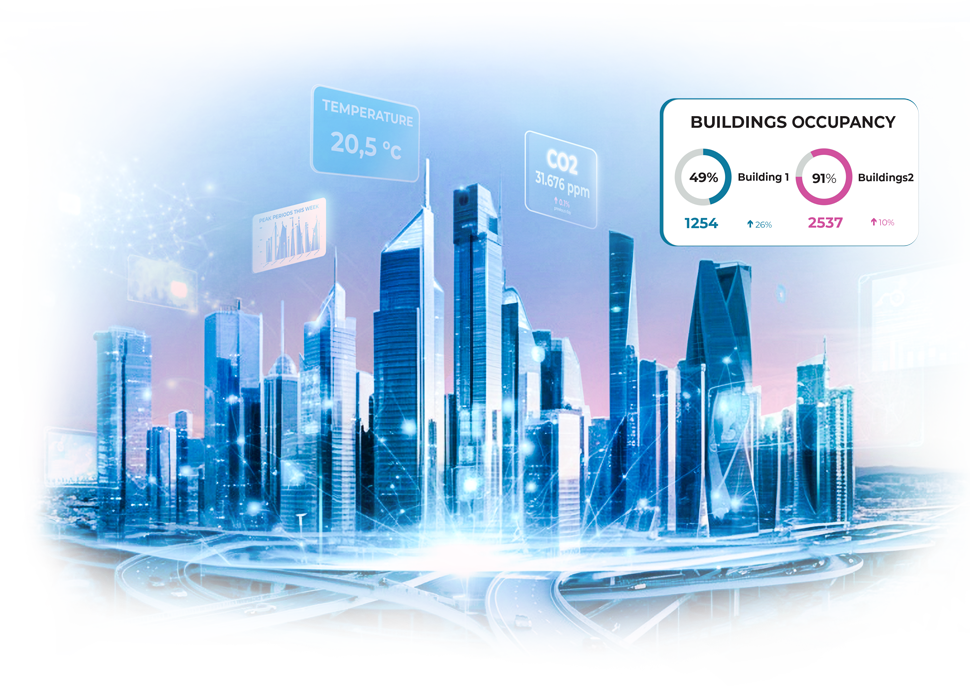In most office buildings, the lights are on - even when no one’s there.
HVAC systems hum away on fixed schedules, cleaners tidy empty rooms, and meeting spaces sit booked but unused. It’s so common that most facility teams barely notice it anymore.
But every unnecessary hour of lighting, cooling, or heating drives up costs and carbon emissions. Every ghost meeting room fuels employee frustration. And every operational decision made without real-time data risks missing the mark.
Real-time occupancy insights change this. By showing exactly how spaces are used - minute by minute - they allow offices to adapt on the fly, run more efficiently, and support both ESG targets and employee satisfaction.
1. Cut Energy Waste Without Compromising Comfort
Heating and cooling are among the biggest operational expenses for any office building. Yet most systems still run on time-based schedules - cooling entire floors even if only a handful of people are there.
By connecting HVAC systems to live occupancy data, temperature and ventilation automatically adjust based on the number of people in a space. That means you’re not overcooling empty meeting rooms or underheating busy collaborative areas.
This approach has delivered significant reductions in HVAC energy use in pilot projects, while maintaining - and in some cases improving - indoor comfort levels.
2. Automate Smarter Cleaning and Maintenance
Cleaning schedules are often dictated by the clock, not by actual need. The result? Some areas get cleaned unnecessarily, while others stay messy longer than they should.
Occupancy data flips that model. When cleaning teams know which areas have been used most, they can prioritize high-traffic zones while skipping untouched spaces. This not only reduces costs but also improves hygiene - a priority in the post-pandemic workplace.
And it’s not just cleaning. Maintenance teams can use the same data to plan servicing based on real wear and tear, extending the life of office assets and reducing downtime.
3. End the “Ghost Meeting Room” Problem
Ask any office manager, and they’ll tell you: ghost bookings - when rooms are reserved but go unused - are a constant frustration. They waste prime meeting space, frustrate employees, and can even skew space-planning decisions.
With real-time occupancy monitoring, you can automatically release rooms if no one shows up within a set time, freeing them for others to use. Over time, the data also reveals which rooms are consistently underused, helping you repurpose space for more in-demand functions.
4. Support ESG and Compliance Goals with Data You Can Trust
Sustainability reporting is no longer optional. Many organizations now need to prove progress toward net-zero emissions, better space utilization, and resource efficiency.
Real-time occupancy data offers a verifiable trail of how and when spaces are used, which feeds directly into ESG reporting frameworks. Whether you’re working toward LEED (Leadership in Energy and Environmental Design), BREEAM (Building Research Establishment Environmental Assessment Method) or internal corporate targets, this level of transparency makes compliance easier, and more credible.
5. Improve Employee Comfort and Experience
The best offices are more than buildings - they’re environments that adapt to people’s needs. With live occupancy data, companies can make quick adjustments to improve comfort:
-
Opening additional work areas when demand peaks
-
Adjusting lighting levels in quieter zones
-
Ensuring collaborative spaces aren’t overcrowded
The result is a workplace that feels responsive, not rigid - and that’s a powerful advantage in attracting and retaining talent in a hybrid-work world.
One Platform, Global Rollout
For organizations with multiple offices across regions, the challenge is scaling these capabilities without creating a fragmented tech stack. That’s why Vemco Group’s platform is designed to integrate seamlessly with HVAC systems, building management systems, and other operational tools - all in one place.
From a single dashboard, you can:
-
Compare occupancy trends across locations
-
Trigger automated actions (like HVAC adjustments) in real time
-
Generate role-specific reports for executives, sustainability teams, and facilities managers
-
Roll out updates and new integrations globally with local support in every region you operate
And with >98% counting accuracy and proven experience in international deployments, the data you see is the data you can trust - from Copenhagen to Dubai, Sao Paolo and beyond.
The Office of the Future is Data-Aware
Real-time occupancy insights don’t just save money, they change how offices operate. They make buildings responsive, reduce environmental impact, and give employees a better experience every day.
It’s the difference between running an office on guesswork, and running it with confidence.
When your office becomes data-aware, everything changes - for your people, your planet, and your performance.
Frequently Asked Questions
How does real-time occupancy data improve modern office efficiency?
Real-time occupancy data helps organizations monitor workspace usage, optimize seating arrangements, reduce underutilized areas, and make data-driven decisions to improve employee productivity and office cost-efficiency.
What is a ghost meeting and how can occupancy data prevent it?
A ghost meeting occurs when a booked conference room or workspace is left empty or underused. Real-time occupancy monitoring identifies these unused bookings, helping offices reclaim space and reduce scheduling inefficiencies.
Can real-time occupancy analytics support hybrid work models?
Yes, occupancy analytics provide insights into which areas are most used, helping organizations plan flexible seating, hot-desking, and hybrid work schedules while ensuring employee comfort and safety.





